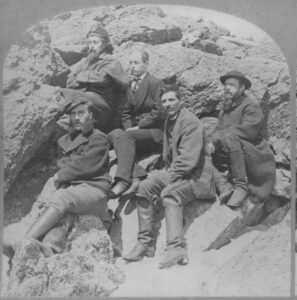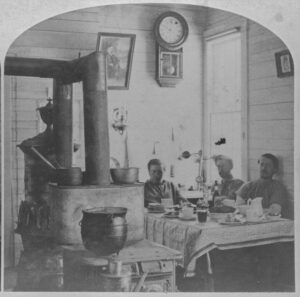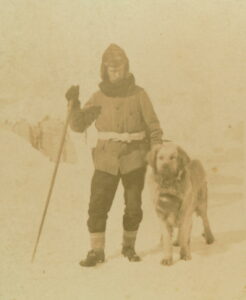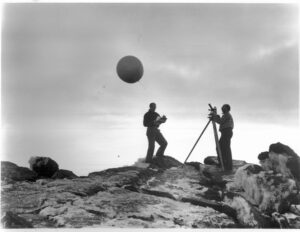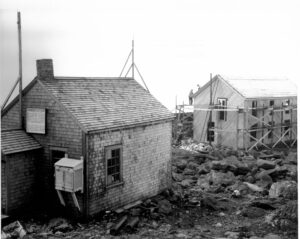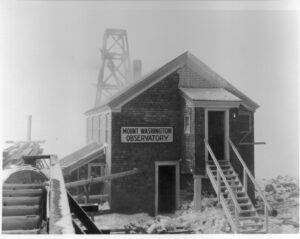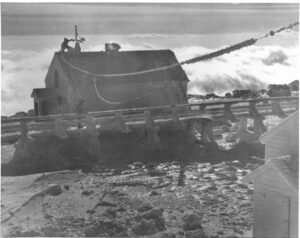Our History
Mount Washington’s infamous weather has captivated visitors and scientists alike
for hundreds of years
By Dr. Peter Crane
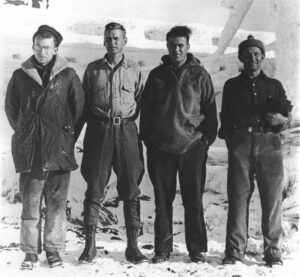
The founding crew, 1932-1933: McKenzie, Monahan, Dodge, Pagliuca.
The Mount Washington Observatory was founded in 1932, but the history of weather observation on Mount Washington goes back to the winter of 1870-1871. It was then that the mountain’s summit was first occupied for scientific purposes. A private expedition was led by Dartmouth professor Charles H. Hitchcock and his assistant, Joshua H. Huntington. The expedition was housed in a Mount Washington Cog Railway building, graciously lent by the Railway, and included three other crew members, one of whom was a soldier detailed to the endeavor by the U.S. Army Signal Service, our nation’s first weather service. The winter was a harsh one, but daily observations of the mountain’s weather were made by the hardy crew. The information was relayed to the valley via telegraph and was used to help create weather forecasts for the region.
Following that first successful winter, the U.S.Army Signal Service maintained a weather station on Mount Washington year-round into 1887, and in summer only through 1892.
The reoccupation of the summit of Mount Washington for scientific work occurred in the winter of 1932-1933, thanks to a cadre of individuals who were keen to learn more about the mountain and its weather. The effort was championed by Joseph B. Dodge, who worked at the mountain’s eastern base in Pinkham Notch, and who served as Huts Manager for the Appalachian Mountain Club (AMC). A colleague in establishing the weather station was Robert S. Monahan, a recent Dartmouth graduate.

Alex McKenzie and Joe Dodge in the Observatory’s radio room.
Both Dodge and Monahan were familiar with the 19th century pioneers who had spent time on the summit, and found inspiration in their good work. Monahan had spent a week in December 1926 on the summit, taking weather observations. Dodge visited Monahan on the peak, and the notion of a full winter’s occupation of the summit was born.
The realization of that project was delayed, but in 1932, Dodge and Monahan made it happen. They were assisted in the planning by Charles Brooks of Harvard University and Blue Hill Observatory in Milton, Massachusetts, who was the founder of the American Meteorological Society. Also of assistance was Dartmouth professor James W. Goldthwait, president of the New Hampshire Academy of Science, who encouraged the Academy’s financial support of the project. A significant factor in the timing of the project was the occurrence of the International Polar Year, a world-wide effort to observe and better understand geophysical phenomena of the high latitudes and at high altitudes.
While Dodge’s responsibilities at Pinkham Notch meant that he would serve as valley liaison, and not spend much time at the summit, Monahan was joined there by Salvatore Pagliuca, an electrical engineer, and Alexander McKenzie, an experienced radio technician. Thanks to the generosity of the Mt. Washington Auto Road free use of the summit Stage Office was provided to the expedition.

The Observatory’s first home, the 1908-built Stage Office of the Mount Washington Summit Road Company.
The reoccupation of the summit began on October 14, 1932. Foremost among the work of the Observatory staff was regular weather observations. The crew members were also involved in testing radio equipment. Observers also performed balloon soundings, to learn more about the air circulation patterns that were found in mountain regions. The Observatory crew worked with the AMC to better inform mountain visitors about the harsh and dangerous weather so often found on Mount Washington.
While the original concept was to operate the weather station for only one year, the success of the work there led Dodge, Brooks, and others to continue operations for another year. That year was a momentous one, as April 12, 1934 saw a truly remarkable event, the clocking of a world record wind of 231 miles per hour. The noteworthy weather, and the capable recording of such a weather extreme, helped secure a long-term place on the mountain for the Observatory.
As the 1930’s progressed, so did the Observatory. In 1937, Henry Teague, operator of the Mount Washington Cog Railway, erected a structure exclusively for the Observatory. A remarkably strong building whose framework was made of railroad trestle timbers, it was rented to the Observatory on generous terms. This period also saw the start of a formal relationship with the United States Weather Bureau, the predecessor to today’s National Weather Service, with which the Observatory continues to work closely in its weather observation program. 1937 also saw the start of the Observatory’s membership program, to encourage public support of its important activities. The Observatory’s News Bulletin, now called Windswept, had its first issue published in that year.
The war years of the early 1940’s were challenging ones for the Observatory. Staff members were hard to come by, with so many suitable candidates in the military or in war-related work. But the Observatory persisted, knowing that its weather information and its summit research were small but important parts of the war effort. After World War II, Mount Washington became a focal point for cold-weather research, especially related to atmospheric icing and its effect on aviation, including the new technologies of jet aircraft and helicopters. Such research work was led by the United States military and by large civilian contractors, with the Observatory also playing a role in such work. Research activities in this era of the Observatory focused on a variety of topics such as the nature of atmospheric icing, cloud seeding, atmospheric electricity, and cosmic radiation.

A jet testing facility on the summit.
 The 1960’s and 1970’s saw a continuation of partnerships with various organizations on a variety of scientific research projects. This period also saw some major changes for the Observatory. While the organization had long played a role in informing and educating the public about the mountain, weather, and the alpine environment, that activity became more pronounced as the number of visitors increased in the 1960’s. To answer the need for enhanced public contact opportunities, the Mount Washington Museum was opened in 1973. The Museum, now in the Sherman Adams Building and currently known as “Extreme Mount Washington,” continues service to this day.
The 1960’s and 1970’s saw a continuation of partnerships with various organizations on a variety of scientific research projects. This period also saw some major changes for the Observatory. While the organization had long played a role in informing and educating the public about the mountain, weather, and the alpine environment, that activity became more pronounced as the number of visitors increased in the 1960’s. To answer the need for enhanced public contact opportunities, the Mount Washington Museum was opened in 1973. The Museum, now in the Sherman Adams Building and currently known as “Extreme Mount Washington,” continues service to this day.
In 1980, the Observatory moved its weather station into the new Mount Washington State Park Sherman Adams Building. The new location for the Observatory had more suitable space for staff quarters and for visiting scientists. And in 1991, the Observatory opened a valley office in North Conway, to serve as a support facility for its on-the-mountain operations, and to house the Observatory’s research library and archives.

Mount Washington State Parks’ Sherman Adams Summit Building
In 1993, the Observatory expanded its educational offerings to include EduTrips, winter overnight visits to the summit providing instruction in topics pertinent to the mountain environment. While Observatory staff have, for many decades, provided in-person presentations to educational and civic groups about the Observatory and Mount Washington, those activities have been enhanced in recent years with more virtual programs, plus a renewed attention to programs for schools, science centers, libraries, and other such venues.
In recent years, the Observatory has originated or participated in many studies of the mountain environment. As concern for changes in Earth’s climate have become greater, the value of the Observatory’s long meteorological record has been better recognized, with detailed studies of the record made by Observatory staff and other researchers, such as those of the AMC. Lessons learned measuring wind on the summit for nearly a century have been applied to further enhance the performance of the Observatory’s wind instruments, and have also been applied to developing wind instruments to monitor conditions near the summit of Mount Everest.
Now approaching one hundred years of service to the scientific community and to the public, the Mount Washington Observatory continues its work in the three main areas of activity for which it was founded: to maintain a rigorous program of weather observations and related environmental monitoring, to perform and to collaborate with others in performing basic and applied scientific research, and to participate in public education about weather, climate, and the mountain environment.
-Dr. Peter Crane
Mount Washington Observatory

